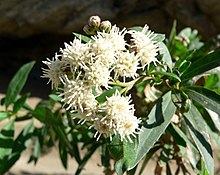Baccharis salicifolia
| Mule fat | |
|---|---|

| |
| Scientific classification | |
| Kingdom: | Plantae |
| Clade: | Tracheophytes |
| Clade: | Angiosperms |
| Clade: | Eudicots |
| Clade: | Asterids |
| Order: | Asterales |
| Family: | Asteraceae |
| Genus: | Baccharis |
| Species: | B. salicifolia
|
| Binomial name | |
| Baccharis salicifolia | |
| Synonyms | |
| |
Baccharis salicifolia is a blooming shrub native to the sage scrub community and desert southwest of the United States and northern Mexico, as well as parts of South America. Its usual common name is mule fat;[3]: 126 it is also called seepwillow or water-wally. This is a large bush with sticky foliage which bears plentiful small, fuzzy, pink, or red-tinged white flowers which are highly attractive to butterflies.[4] It is a host plant for the larval stage of the fatal metalmark butterfly, and the adult stage also nectars on the flowers.[5]
The long pointed leaves may be toothed and contain three lengthwise veins. It is most common near water sources.
The seed is wind-distributed.[6]
Uses
[edit]The Kayenta Navajo people use this plant in a compound infusion of plants used as a lotion for chills from immersion.[7]
Another use is fire starting. Dried Baccharis salicifolia has a very low ignition temperature, very similar to the dried yucca stalk. It can be used for spindles and hand-drill shafts.
Galls
[edit]Mulefat plays host to several gall-inducing insect species including Aceria baccharices.[8]
References
[edit]- ^ Redonda-Martínez, R.; Zacarias-Correa, AG; Machuca Machuca, K.; Samain, M.-S. (2022). "Baccharis salicifolia". IUCN Red List of Threatened Species. 2022: e.T126029547A167073592. doi:10.2305/IUCN.UK.2022-1.RLTS.T126029547A167073592.en. Retrieved 6 April 2023.
- ^ "NatureServe Explorer 2.0". explorer.natureserve.org. Retrieved 6 April 2023.
- ^ Mojave Desert Wildflowers, Pam MacKay, 2nd ed., 2013, ISBN 978-0-7627-8033-4
- ^ Soule, J.A. 2012. Butterfly Gardening in Southern Arizona. Tierra del Soule Press, Tucson, AZ
- ^ "Baccharis salicifolia - Butterflies". calscape.org. Retrieved 2024-01-25.
- ^ "Mule Fat". www.fs.usda.gov. Retrieved 2024-01-25.
- ^ Wyman, Leland C. and Stuart K. Harris 1951 The Ethnobotany of the Kayenta Navaho. Albuquerque. The University of New Mexico Press (p. 45)
- ^ "Aceria baccharices (Mule Fat Blister Mite)". iNaturalist.
External links
[edit]- Jepson Manual Treatment
- Photo gallery
 Media related to Baccharis salicifolia at Wikimedia Commons
Media related to Baccharis salicifolia at Wikimedia Commons
- IUCN Red List least concern species
- NatureServe secure species
- Baccharis
- Flora of Northwestern Mexico
- Flora of the Southwestern United States
- Flora of Arizona
- Flora of Baja California
- Flora of California
- Flora of Colorado
- Flora of New Mexico
- Flora of Nevada
- Flora of Texas
- Flora of Utah
- Natural history of the California chaparral and woodlands
- Flora of the California desert regions
- Flora of the Cascade Range
- Flora of the Klamath Mountains
- Flora of the Sierra Nevada (United States)
- Flora of the Sonoran Deserts
- Natural history of the California Coast Ranges
- Natural history of the Central Valley (California)
- Natural history of the Channel Islands of California
- Natural history of the Colorado Desert
- Natural history of the Mojave Desert
- Natural history of the Peninsular Ranges
- Natural history of the San Francisco Bay Area
- Natural history of the Santa Monica Mountains
- Natural history of the Transverse Ranges
- Plants used in traditional Native American medicine
- Taxa named by José Antonio Pavón Jiménez
- Taxa named by Hipólito Ruiz López
- Medicinal plant stubs
- Astereae stubs


